Late Summer Yellowstone Fishing Trips
Posted on January 24th, 2024
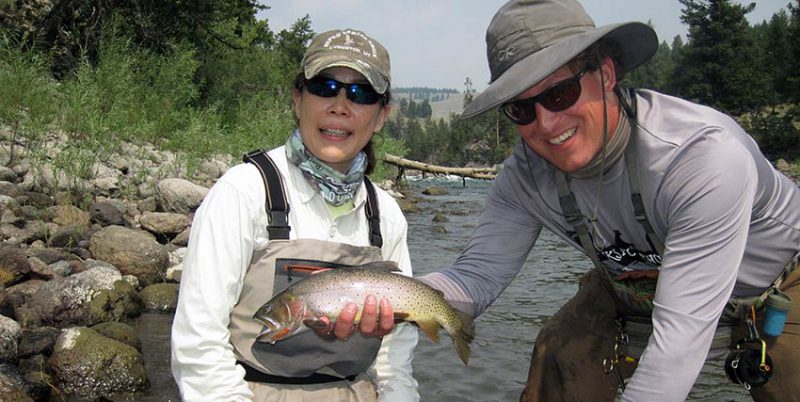
The Black Canyon of the Yellowstone remains a key hike-in destination on our August Yellowstone fishing trips. This fish ate a grasshopper.
Late summer, which begins in late July or early August and continues until the first cold nights in late August or early September (henceforth just called ‘August’), continues to offer excellent hike-in fishing, and both the hikes and the wading are usually not so onerous at this time as in early summer. In addition, this is prime time for small, rough mountain creeks that might still be too high in early summer. Regardless of locale, August Yellowstone fishing trips are excellent bets for anglers who like fishing terrestrial dry flies, and can turn out some big fish on subsurface flies, as well.
The downsides of late summer are continued crowds, especially on famous waters that flow through meadows, and potentially low, clear, and somewhat warm water than might mean we have to start fishing early in the morning and quit at midafternoon to avoid stressing the trout. The latter issue is much more common during drought years.
More wade-fishing options also up outside Yellowstone Park. While stretches of the Yellowstone River that don’t see much boat traffic remain our bread and butter option, lower flows also make it possible to wade several small streams safely (and legally), and the Boulder River is now too low to float, opening it up for wading anglers. While a bit out of the way, these options also enjoy less traffic than easy-access waters in the park.
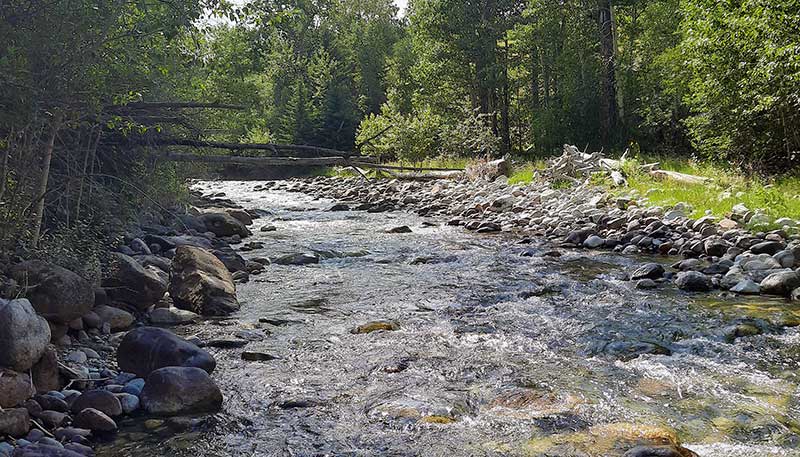
Several Montana creeks provide changes of pace to Yellowstone Park in August. No, I won’t name this stream online.
Late Summer Yellowstone Fishing Trips: Quick Facts
- Best Waters: Deeper, more turbulent rivers and streams are usually best in late summer: The Yellowstone, Gardner, rough portions of the Lamar River and Slough Creek, and many shady, rocky mountain creeks are top choices.
- Three Top Reasons to Come in Late Summer: 1.) Excellent attractor and terrestrial dry fly fishing is common on most waters. 2.) Wading is much easier than it is earlier in the year. 3.) We typically see more large fish in late summer versus early summer.
- Three Top Reasons to Avoid Late Summer: 1.) The fishing is less consistent than early summer, particularly during drought years. 2.) There are fewer insect hatches at this time than earlier or later in the season, so we fish attractor and terrestrial dries, nymphs, and streamers more than we match hatches. 3.) While not as crowded overall as early summer, the park and its waters are still pretty busy.
- Perfect Clients: Late summer is ideal for adventurous, fit anglers who enjoy fishing steep, rugged rivers and streams, whether they’re looking for numbers of smaller trout on dry flies or big ones on nymphs and streamers.
- What Late Summer Does Best: Produces good action for medium-sized fish with attractor and terrestrial dry-dropper combinations, while providing some opportunities for large fish on nymphs and streamers.
August Trips: The Details
Beginning in the last few days of July, the fishing in Yellowstone Park begins to shift to terrestrial insects. On steeper and broken streams that see lower pressure, this generally means grasshopper and cricket imitations. On streams with gentle gradients where pressure is heavier, it generally means ant and beetle imitations, while certain streams and the Gallatin River can see phenomenal falls of spruce budworm moths that really get the trout excited.
Aquatic insect hatches fall off in August, though we’ll occasionally see sparse mayfly hatches. These hatches are most likely when the weather is gray.
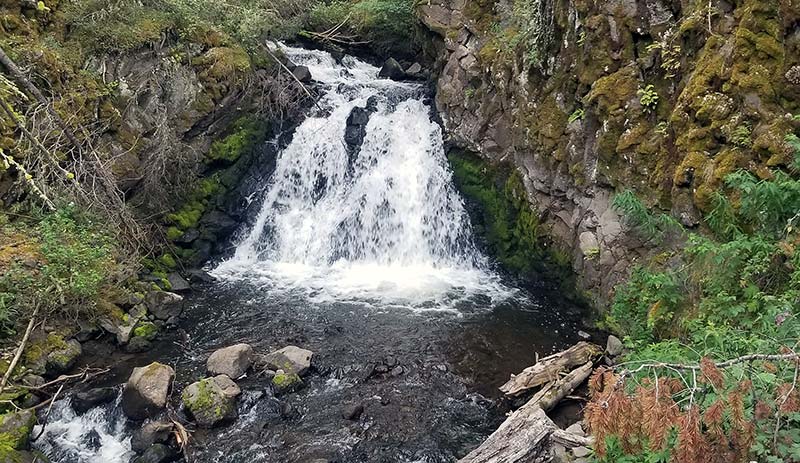
Small, cold, mountain creeks provide excellent fishing on hot August afternoons, as well as a few surprises. When I first explored this creek in the northeast part of the park, I didn’t know about this waterfall.
Speaking of gray weather, it’s not uncommon to have a few cold, rainy days in August, especially in the latter half of the month, though the average weather is still warm and sunny. We actually like cold days in August, because they reduce water temperatures and the forest fire danger.
Other than slight changes in the flies we use and the venues we fish, there are fewer changes with the transition to late summer on Yellowstone Park trips than on other guided trips.
The Yellowstone in its canyons remains our favorite destination for walk trips. Portions of Slough Creek, the Lamar, and the Gardner the main big-water support acts for experienced anglers. For experienced anglers who love small stream fishing, steep mountain creeks are usually better than gentle creeks on August Yellowstone fishing trips, both because the steep creeks may just be getting low enough to be prime by this point and because they are usually deeper, colder, and better oxygenated.
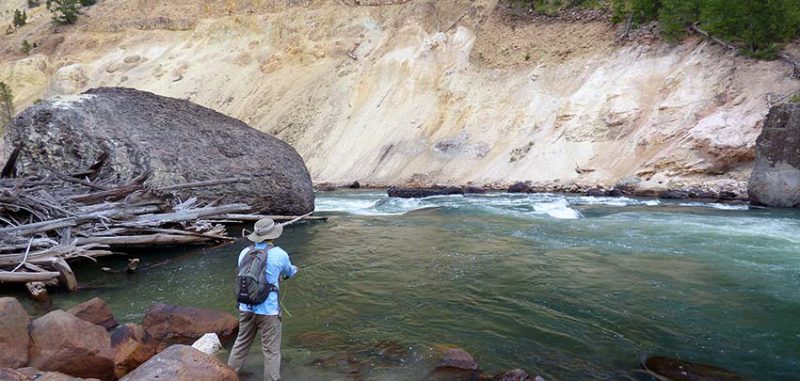
Angler fishing a streamer in a deep hole in the Grand Canyon of the Yellowstone River in late summer. The spot where he’s standing is inaccessible in early summer.
Deep, cold, and well-oxygenated water can be critical in late summer, especially in early August when the nights are still warm and the days still blazing hot. In drought years, water temperatures can be too warm in late afternoon. This is most common on shallow waters at low elevation, such as the lower Gardner River and the Yellowstone just before it exits the park.
When we run into warm water issues, we’ll either need to start fishing extremely early in the morning and quit at midafternoon or head to the high country to fish a small stream once bigger rivers get too warm for ethical (to say nothing of productive) fishing.
Beginner fishing on small brook trout streams remains good in late summer, though often we’ll fish steeper and faster streams and small rivers than we do earlier in the summer, for the same reasons just noted. By about August 20, the brook trout fishing falls off sharply and our beginner brookie family trips stop making much sense. In fact, after about August 20 most beginner anglers actually catch more fish on float trips than they do on Yellowstone Park hike and wade trips.
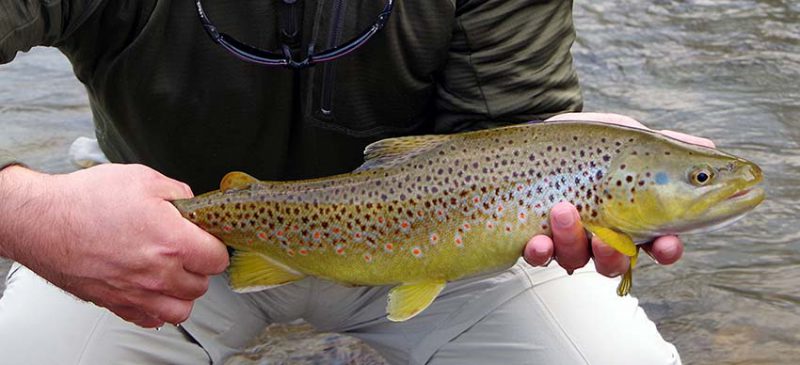
Some big early morning trout are possible in late August.
Our focus often shifts on late August Yellowstone fishing trips, just as the weather starts shifting towards fall. Gray weather often prompts the first hatches of fall aquatic insects, the Blue-winged Olives and Tan Drakes. Gray weather and especially a few cold nights also increase our chances of catching larger trout on nymphs and streamers, especially for anglers willing to get out on the water before dawn to be in position and ready to make our first casts right at dawn when it’s legal to start fishing.
Otherwise, late August continues to fish like early August. Late August is therefore a bit of a changeover period: sometimes it fishes as described above, while sometimes we’ll want to go into “early fall” mode, at least for the first couple hours we’re fishing.
July Yellowstone Fishing Trips
Posted on January 24th, 2024
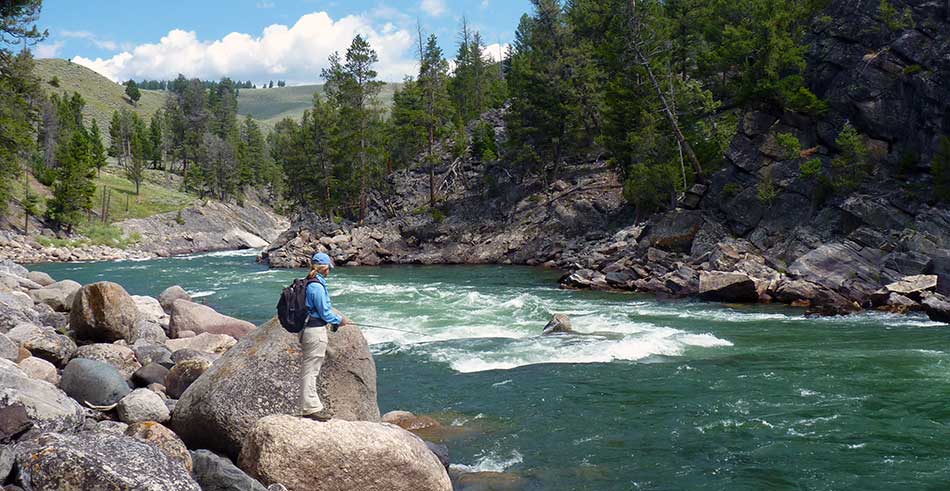
The Black Canyon of the Yellowstone, seen here, is a prime destination in July.
Introduction to July Yellowstone Fishing Trips
Early summer (basically the month of July) is prime time for hike-in walk-wade fishing in Yellowstone Park on all larger streams as well as many small creeks suitable for beginners and experts alike. July Yellowstone fishing trips are great for those eager to chase cutthroat trout on the Yellowstone River and rugged portions of the Lamar River and Slough Creek. It’s also a good bet for those hoping to hit the fabled Salmonfly hatches without the crowds that accompany this major hatch on rivers large enough for float trips.
On the other hand, this is also prime time for crowds, so to find good fishing or at least uncrowded fishing, hiking is basically required, and the hikes can be hot since this is also the hottest time of year.
Wade-fishing on Montana waters is much more limited, basically due to high water, but some half-day wade options are available on the Yellowstone River near Gardiner. This is very rough and rugged fishing, but it is also usually very good fishing, since the area where we fish on these trips sees almost no boat traffic. This makes Montana wade trips a good way of shedding crowds—both the wade-fishers in the Park and the boats elsewhere on the Yellowstone.
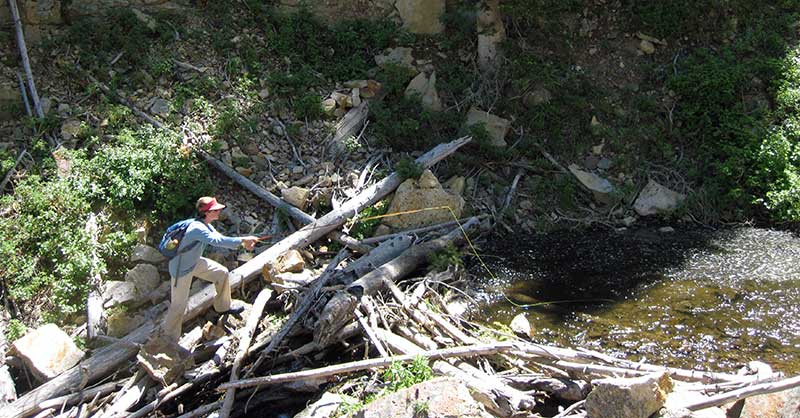
So are many small streams, though most aren’t quite this rugged.
Early Summer Yellowstone and MT Fishing Trips: Quick Facts
- Best Waters: The sky is the limit in early summer. Large and small rivers like the Yellowstone, Gardner, and Lamar are good now, as are all of their tributaries. YCFF tends to focus on hike-in sections of the Yellowstone, Lamar and tributaries, and Gardner and tributaries.
- Three Top Reasons to Come in Early Summer: 1.) Early summer offers the widest range of fishable waters in YNP, as well as the most consistent fishing overall. 2.) Except for occasional thunderstorms, the weather is at its most consistent during this period. 3.) This is the best time of year to match hatches in Yellowstone Park, from small mayflies on up to the fabled Salmonfly.
- Three Top Reasons to Avoid Early Summer: 1.) This is the most crowded time of year for both general tourism and anglers in the park. 2.) This is the hottest time of year, so hiking can sometimes be a sweaty affair. 3.) Rivers can still be high, so wading is tougher now than in late summer and fall.
- Perfect Clients: Early summer is ideal for adventurous, fit anglers eager to hike who are willing to put up with crowded roads and sometimes crowded rivers (even in the backcountry) in exchange for the most consistent fishing of the year, if not always the best fishing of the year.
- What Early Summer Does Best: Provides a huge range of fishing opportunities, from small fish in small streams to large cutthroat trout in big rivers.
July Trips: The Details
When the rivers across the northern portion of Yellowstone Park drop out of their spring runoff between the last week of June and the middle of July, options for walk-wade trips spike dramatically. The month or so following the end of the runoff offers the widest range of options for walk trips, especially for beginners, anglers who like to hike, and those who want to chase cutthroat trout.
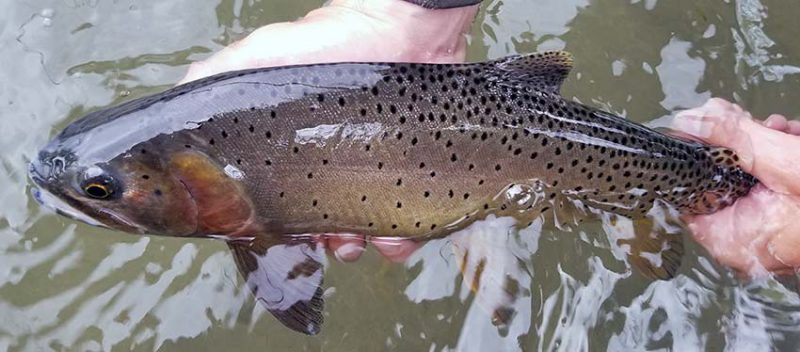
Native Yellowstone cutthroat trout are a primary target species in July, both inside and outside the park.
The best options for full-day trips for experienced anglers throughout this period are the Yellowstone in its Grand and Black Canyons and rugged portions of Slough Creek and the Lamar River. We’ll often put together a trip focusing on one of these waters for most of the day that concludes on the Gardner River or one of the fun, out-of-the-way small streams that becomes fishable at this time.
Because angler crowds are heavy near the roads in early summer, it is vitally important to hike to shed crowds. When possible, we also like to fish water with rugged banks and fast water, because such a stream character really deters the masses. The ultimate example of this type of water is found on the canyon sections of the Yellowstone, which explains why this is by far our favorite walk-in river for experienced anglers during the summer.
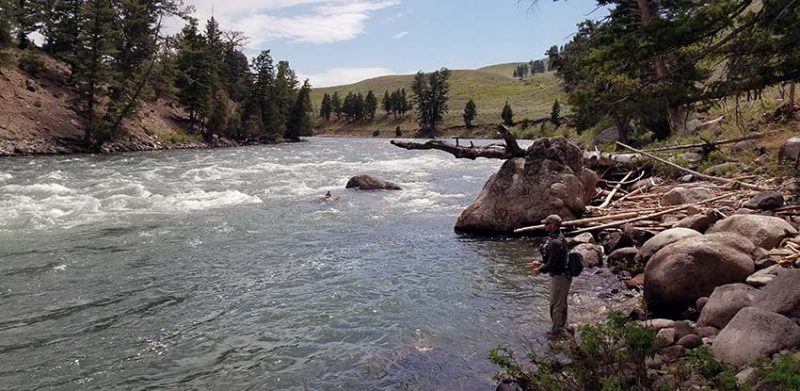
On July Yellowstone fishing trips, most Yellowstone River fishing inside the park revolves around the Salmonfly and Golden Stonefly hatch. While this hatch typically lasts only a week or ten days outside the park, it can last as much as a month inside it. These finger-length bugs can attract even the largest trout to the surface.
Even if they don’t want to rise, the fish will take big nymphs hung as droppers under large dry flies. When the fish want an “after dinner mint” instead of the main course, smaller attractor dries and attractor nymphs also work well, especially during caddisfly or Yellow Sally stonefly hatches.
Our Yellowstone fishing guides usually carry a spare rod rigged with streamers on the Yellowstone, and the streamers can be a blast to fish in the deep green pools found on this stretch of the Yellowstone. The trout here love to chase, and will often follow flies during the retrieve all the way to the rod tip before striking, making for the most visual streamer fishing we’ve ever found.
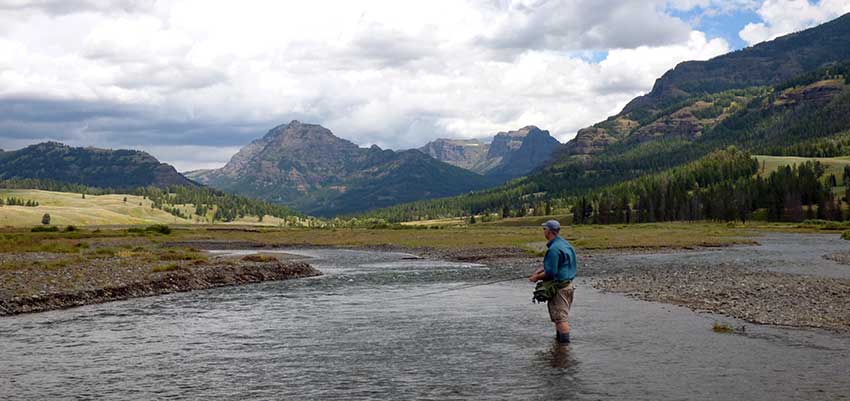
The view is definitely part of the appeal on Soda Butte Creek.
Mayfly hatches are also excellent on certain waters during this period, particularly the Western Green Drake hatches which can get the fish really excited. These hatches are most common on the Lamar River and its main tributaries Slough Creek and Soda Butte Creek, as well as a few smaller streams.
For anglers interested in this match-the-hatch fishing, we typically guide on the rugged portions of the Lamar and Slough, as well as on a couple waters we won’t name online. This water is suitable for anglers of a variety of skill levels, provided they’re up for some rock-hopping.
We also guide on the meadow portions of the Lamar, Soda Butte, and Slough Creek, though it is often very difficult to shed crowds on these waters. The views can’t be beat, though.
Beginner options are great at this time. Enthusiastic beginners can do well on many small, rough streams holding cutthroat, rainbow, and brown trout. Those who want to be sure of catching a bunch of fish (though no big ones) should think about starting with a half-day on a small brook trout stream. Often a half-day on such a creek is enough, but many beginners like to combine a half-day on a brookie creek with an afternoon on more-challenging water on the Gardner or Yellowstone after lunch, trying to add a couple bigger, harder fish to the mix.
Full-day and half-day trips are available at this time. We start almost all Yellowstone Park trips in early summer between 6:00 and 7:00 depending on our meeting place and travel time. It’s vital to be through the gate before about 7:45 to avoid risking a half-hour line waiting to get in. Montana half-days are more likely to start at midmorning.

July is prime beginner season.
Late Spring Yellowstone Park Fishing Trips
Posted on January 24th, 2024
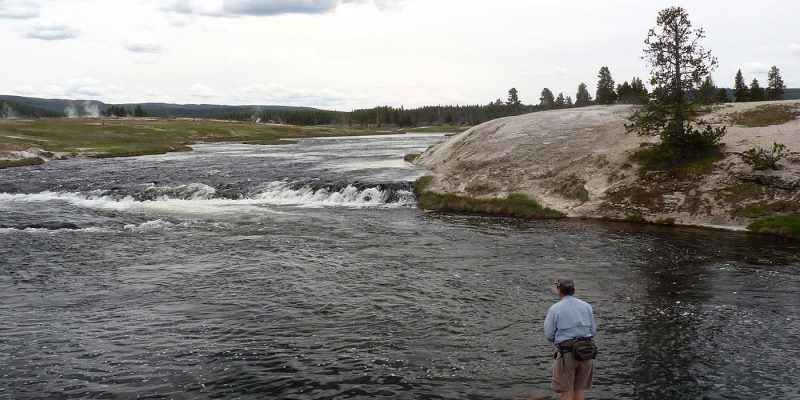
Angler fishing a pool on the Firehole in early spring.
Introduction to Late Spring Yellowstone Park Fishing Trips
Yellowstone Park opens to fishing at sunrise on the Saturday of Memorial Day Weekend. On the opener, usually only one to three rivers are low enough and clear enough to fish due to spring snowmelt. These rivers, the Firehole, Gibbon, and the headwaters of the Madison (created by the junction of the Firehole and Gibbon), are fed by lakes and geyser basins, so they never get as high and muddy as other rivers in the park. This makes them by far the best options for late spring Yellowstone Park fishing trips.
There are no good public water walk & wade options available outside the park in this timeframe within our operations area, due to the spring melt and accompanying high, muddy water.
In dry years, more river options are available in early June, particularly the Grand Canyon of the Yellowstone and the lower Gardner. They’re fishable before June 15 no more than one year in three, though. Better options that usually become fishable sometime in the first week or two of June are several hike-in lakes and a small handful of gently-flowing creeks.
After mid-June, the Grand Canyon of the Yellowstone and lower Gardner become steadily better options even in wet years, while the Firehole drops off. Sometime in late June or the first few days of July, the Firehole and Gibbon both get tough and the rest of the water across the northern part of Yellowstone Park joins the Gardner and Grand Canyon, and the fishing transitions to early summer.
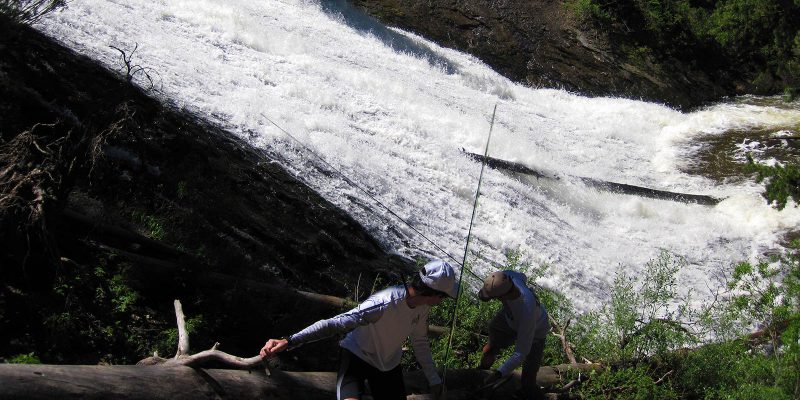
Young anglers climbing out of a rough section of the Gibbon River after fishing.
Late Spring Walk & Wade Trips: Quick Facts
- Best Waters: The Firehole, Gibbon, and Madison Rivers are the most consistent waters in late May and June, but a few small lakes and streams join them in the second week of June or so.
- Three Top Reasons to Come in Early Spring: 1.) You are interested in fishing the geothermal Firehole and Gibbon, where geysers and hot springs compete with trout for your attention 2.) General tourist crowds are always modest, and angler crowds are low except in roadside areas. 3.) After lakes begin to clear, this is a great time to fish for Arctic grayling.
- Three Top Reasons to Avoid Early Spring: 1.) Most Yellowstone Park trout caught at this time are small. 2.) The weather is inconsistent, particularly before June 10 (it might snow or be 80 degrees). 3.) Fewer fisheries are good in spring than during peak season; in fact there are no wade options outside the park at this time.
- Perfect Clients: Spring fishing in Yellowstone Park is ideal for anglers who don’t mind smaller trout and grayling in exchange for smaller crowds and good opportunities for wildlife and geyser viewing to go with the fishing.
- What Early Spring Does Best: Produces good numbers of smaller trout on dry flies and dry-dropper rigs, but only in a few places.
Late Spring Yellowstone Park Fishing Trips: The Details
In the first couple weeks of the season, we spend most of our time on spring Yellowstone fishing trips on the Firehole and Gibbon. The geyser-heated Firehole River is typically at its very best for the first couple weeks of the season. In dry years, the Gibbon River is also good right out of the gate, and even following cold, wet winters it is usually ready to go between June 5 and June 10.
Since the Firehole is a gentle, meadow river with heavy insect hatches and spooky (though mostly small) trout that fishes best in the mornings, and much of the Gibbon is fast and rocky, filled with trout eager to eat attractor dry/dropper combos, and good in the afternoons, these two streams make an excellent one-two punch to open the park season. The Firehole is awfully far from Livingston, so it’s only available for full-day trips, but the Gibbon is a reasonable option for half-days.
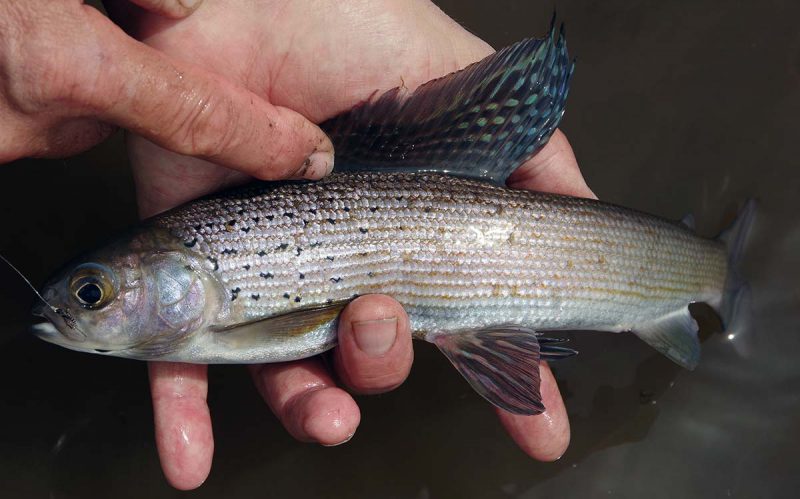
Early June grayling from a Yellowstone Park lake.
For anglers interested in something different, some excellent small lakes become available after approximately June 5, particularly Cascade Lake, which holds gorgeous cutthroats and the best populations of the rare Arctic grayling in the region. We’ll often pair this lake in the morning with the Gibbon after lunch in mid-June. This pairing too provides a good mix of fishing, since the lake is either subsurface fishing with nymphs and streamers or match-the-hatch dry fly fishing, while the Gibbon continues to be an attractor dry fly show.
This trip is a good choice for beginners, especially since we can work on casting without the complication of current on the lake. This trip is a full-day only option, and we’ll want to be hitting the trail by 9:00AM.
A few other lakes also turn on in early June, including some which hold larger cutthroat and brook trout, though these are some combination of much harder to access and much less consistent from a fishing perspective.
By mid-month, additional waters drop out of runoff, with the precise options depending on the progress of the snowmelt. These include options within reasonable half-day range of Livingston. A couple small stream options almost always appear at this time, while for surefooted anglers who like short-range nymphing the Gardner River can be outstanding, since this river is full of big stoneflies that are preparing to hatch and the trout go nuts for them.
During dry years, small portions of the Yellowstone in its lower Grand Canyon also become fishable by mid-June. This is hike-in fishing with big nymphs and streamers, and it often flies under the radar. A few seasons ago we had a client catch a hundred and six trout on a full-day on the Yellowstone at this time. Needless to say, if it’s clear enough, this is where we’ll go in mid-late June.
Since some half-day options are available at this time, we might meet early or around midday. Some of the small stream opportunities at this time are the first “beginner brookie” options of the year. Before that, we tend to fish the Gibbon River with beginners.
>>>>>>>>>>>>>>>>>> Return to Walk & Wade Trips Page
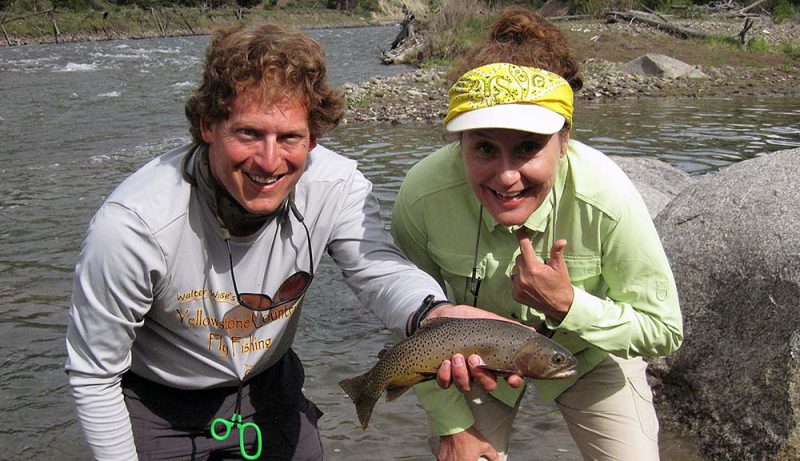
This fish was caught on a spring Yellowstone fishing trip in early June on the Yellowstone River during a low water year.